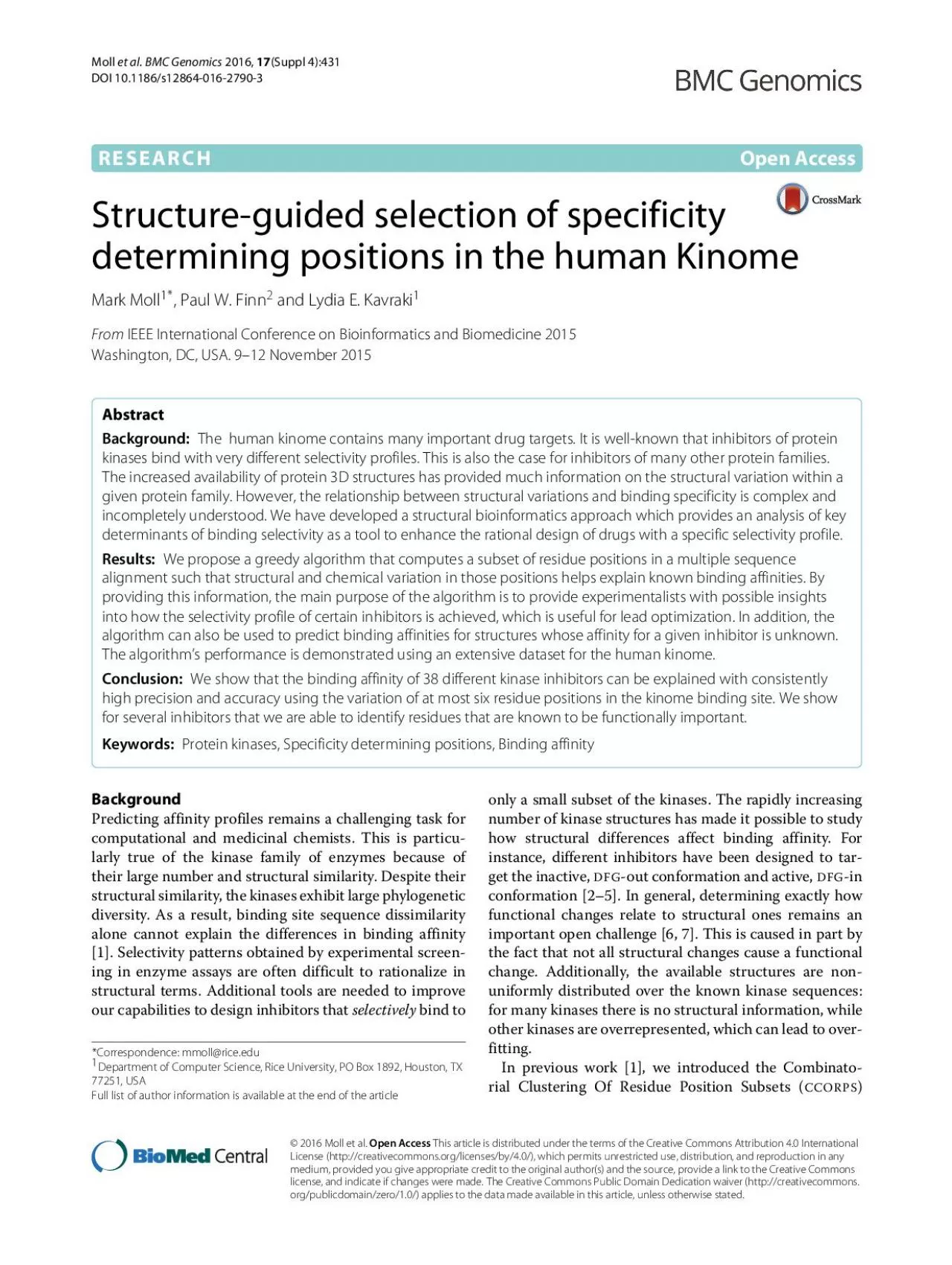

RESEARCHOpenAccessStructureguidedselectionofspecificitydeterminingpositionsinthehumanKinomeMarkMollPaulWFinnandLydiaEKavrakiIEEEInternationalConferenceonBioinformaticsandBiomedicine2015Washington ID: 960736
Download Pdf The PPT/PDF document "etalBMCGenomicsSuppl4431DOI101186s128640..." is the property of its rightful owner. Permission is granted to download and print the materials on this web site for personal, non-commercial use only, and to display it on your personal computer provided you do not modify the materials and that you retain all copyright notices contained in the materials. By downloading content from our website, you accept the terms of this agreement.
etal.BMCGenomics(Suppl4):431DOI10.1186/s12864-016-2790-3 RESEARCHOpenAccessStructure-guidedselectionofspecificitydeterminingpositionsinthehumanKinomeMarkMoll,PaulW.FinnandLydiaE.KavrakiIEEEInternationalConferenceonBioinformaticsandBiomedicine2015Washington,DC,USA.9 12November2015 Thehumankinomecontainsmanyimportantdrugtargets.Itiswell-knownthatinhibitorsofproteinkinasesbindwithverydifferentselectivityprofiles.Thisisalsothecaseforinhibitorsofmanyotherproteinfamilies. *Correspondence:mmoll@rice.eduDepartmentofComputerScience,RiceUniversity,POBox1892,Houston,TX77251,USAFulllistofauthorinformationisavailableattheendofthearticle ©2016Molletal.OpenAccessThisarticleisdistributedunderthetermsoftheCreativeCommonsAttribution4.0InternationalLicense(http://creativecommons.org/licenses/by/4.0/),whichpermitsunrestricteduse,distribution,andreproductioninanymedium,providedyougiveappropriatecredittotheoriginalauthor(s)andthesource,providealinktotheCreativeCommonslicense,andindicateifchangesweremade.TheCreativeCommonsPublicDomainDedicationwaiver(http://creativecommons.org/publicdomain/zero/1.0/)appliestothedatamadeavailableinthisarticle,unlessotherwisestated. etal.BMCGenomics(Suppl4):431Page328of456methodanddemonstratedthatitcouldbeusedtopredictbindingaffinityofkinases.CCORPSconsidersstructuralandchemicalvariationamongalltripletsofbindingsiteresiduesandidentifiespatternsthatarepredictiveforsomeexternallyprovidedlabeling.Thelabelingcancor-respondto,e.g.,bindingaffinity,EnzymeCommissionclassification,orGeneOntologyterms,andonlyneedstobedefinedforofthestructures.CCORPScor-rectsforthenon-uniformdistributionofstructures.FromthepatternsCCORPSidentifies,multiplepredictionsarecombinedintoasingleconsensuspredictionbytrainingaSupportVectorMachine.AlimitationofthisworkisthatitisdifficulttoidentifythemostimportantSpeci-ficityDeterminingPositions(SDPs).Inthispaper,wearenottryingtoconstructabetterpredictor,but,rather,abetterexplanationforsomelabeling.Theexplanationisbetterinthesensethatitprovidesasimpleexplana-tionofalabelingintermsofthedominantSDPs.RatherthanusingpatternsdiscoveredbyCCORPS,itusesasmallnumberofpatternsthatinvolveonlyasmallnum-berofresiduesyetisabletoaccuratelyrecoverbindingaffinity.ThemaincontributionofthispaperisanalgorithmthatcomputestheSpecificityDeterminingPositionsthatbestexplainbindingaffinityintermsofstructuralandchem-icalvariation.Moregenerally,thealgorithmcanidentifyasparsepatternofstructuralandchemicalvariationthatcorrespondstoanexternallyprovidedlabelingofstruc-tures.ThisworkextendsourpriorworkonCCORPS,butshiftsthefocusfromoptimalpredictionstoconcise,bio-logicallymeaningful,explanationsoffunctionalvariation.Therehasbeenmuchworkontheidentificationandcharacterizationoffunctionalsites.Mostofthetech-niquesarebroadlyapplicabletomanyproteinfamilies,butwewillfocusinparticularontheirapplicationtokinases,whenpossible.MuchoftheworkoncomputingSDPsisbasedonevo-lutionaryconservationinmultiplesequencealignments(see,e.g.,[8 10]).Therehasalsobeenworkonrelatingmutationstoanexternallyprovidedfunctionalclassifica-tioninaphylogeny-independentway[11,12].ThisworkissimilarinspirittowhatCCORPSdoes,butbasedonsequencea
lone.Whilesequencealignmenttechniquescanrevealfunc-tionallyimportantresiduesinkinases[13],structuralinformationcanprovideadditionalinsights.Thisisespe-ciallytrueforlarge,phylogeneticallydiversefamiliessuchasthekinases.TheFEATUREframework[14,15]repre-sentsaradicallydifferentwayofidentifyingfunctionalsites.Insteadofalignment,FEATUREbuildsupastatisti-calmodelofthespatialdistributionofphysicochemicalfeaturesaroundasite.Anotherapproachtomodelingfunctionalsiteshasbeenthecomparisonofbindingsitecavities[3,16].In[17]afunctionalclassificationofkinasebindingsitesispro-posedbasedonacombinationofgeometrichashingandclustering.Thisapproachissimilarinspirittoourpriorwork[1],butourworkconsidersvariationsinasmallsetsofbindingsiteresidues,whichmakesitpossibletosep-aratenon-functionalstructuralchangesfromfunctionalones.In[18]amethodcalledFLORAisproposedforanalysisofstructuralconservationacrosswholedomains(ratherthanbindingsites).FLORAwasshowntobeabletoiden-tifyfunctionalsubfamilies(definedbyEnzymeCommis-sionclassifications)withinlargeproteinsuperfamilies.Itreliesontheconstructionofstructuralfeaturevectors,whichsharessomesimilaritieswithourapproach.How-ever,FLORAiscompletelyunsupervisedanditisnotclearhowitcouldbeextendedtoexplainpatternsofkinasebindingaffinity.In[19]manyoftheideasabovearecombinedintooneframework.GivensequencesfromaPFAMalign-ment[20]andsomereferencestructures,homologymodelsareconstructedforallsequences.Next,cav-itiesareextracted,aligned,andclustered.Unlikeourwork,theapproachin[19]iscompletelyunsupervisedanddoesnotaimtoprovideanexplanationforanexternallyprovidedclassification(suchaskinasebindingaffinity).CCORPSoverviewOuralgorithmbuildsontheexistingCCORPSframeworkkCCORPSisasemi-supervisedtechniquethattakesasinputasetofpartiallylabeledstructuresandproducesasoutputthepredictedlabelsfortheunlabeledstruc-tures.Ofcourse,thisisonlypossibleifthelabelscanberelatedtovariationsinthestructures.Inpreviouswork[1]wehaveshownthistobethecaseforlabelingsbasedonbindingaffinityandfunctionalcategorization(EnzymeCommissionclassification).CCORPS[1]consistsofseveralsteps.First,aone-to-onecorrespondenceneedstobeestablishedbetweenrelevantresidues(e.g.,bindingsiteresidues)amongallstructures.Thiscorrespondencecanbecomputedusingamulti-plesequencealignmentorusingsequenceindependentmethods[21 24].Second,weconsiderthestructuralandphysicochemicalvariationamongallstructuresandalltripletsofresidues.Thetripletsarenotnecessarilycon-secutiveintheproteinsequenceandcanbeanywhereinthebindingsite.Eachtripletofresiduesconstitutessubstructure:aspatialarrangementofresidues.Foreachtriplet,wecomputeadistancematrixofallpair-wisedistancesbetweensubstructures.Thedistancemea-sureusedisacombinationofstructuraldistanceandchemicaldissimilarityintroducedin[22].Inparticular, etal.BMCGenomics(Suppl4):431Page329of456thedistancebetweenanytwosubstructuresdefinedas:sidechaincentroidsizealiphaticityaromaticityhydrophobicityhbondacceptorhbonddonorThesidechaincentroidtermistheleastroot-mean-squaredeviationofthepairwise-alignedsidechaincen-troidsofthesubstructures.Theremainingtermsaccountfordifferencesintheaminoacidpropertiesbetweenthesubstructuresasquantifi
edbythepharma-cophorefeaturedissimilaritymatrixasdefinedin[22].Eachrowinthedistancematrixcanbethoughtofasafeaturevectorthatdescribeshowastructurediffersfromallotherswithrespecttoaparticularsubstructure.Thedistancematrixforstructuresishighlyredun-dantandwehaveshownthatthesameinformationcanbepreservedina2-dimensionalembeddingcomputedusingPrincipalComponentAnalysis[25].Each2Dpointisthenareducedfeaturevector.Thesetof2-dimensionalpointsisclusteredusingGaussianMixtureModelsinordertoidentifypatternsofstructuralvariation.Notallstructuralvariationisrelevant;wefocusonpatternsofstructuralvariationthatalignwiththeclassificationprovidedbythelabeling.ThefinalstageofCCORPSisthepredictionoflabelsfortheunlabeledstructures.Supposeaclusterforoneoftheresiduetripletscontainsstructureswithonlyonetypeoflabelaswellassomeunlabeledstructures.Thiswouldsug-gestthatthepredictedlabelfortheunlabeledstructuresshouldbethesameasfortheotherclustermembers.WecallsuchaclusteraHighlyPredictiveClusterHPC).TheseHPCareacriticalcomponentofthealgorithmpresentedinthenextsection.TherearemanyclusteringsandeachclusteringcancontainseveralHPCs(ornoneatall).Forexample,inthehumankinomethebindingsiteconsistsof27residues,leadingto2,925clusterings.Typically,anunlabeledstructurebelongstoseveralHPCsandwethusobtainmultiplepredictions.Thesepredictionsmightnotagreewitheachother.InourpriorworkwetrainedaSupportVectorMachine[26]toobtainthebestconsensuspredictionfromthemultiplepredictions.Structure-guidedselectionofspecificitydeterminingCCORPShasbeendemonstratedtomakeaccuratepredictions,ithasbeendifficulttointerpretthestructuralbasisforthesepredictions.ThishasmotivatedustolookatalternativewaystointerprettheclusteringsproducedCCORPS.Ratherthantryingtobuildabetterpredictor,wehavedevelopedanalgorithmthatconstructsaconcisestructuralexplanationofalabeling.ItdeterminesasetofSpecificityDeterminingPositions(SDPs).Analgorithmthatwouldpredictthatalmosteveryresiduepositionisimportantwouldnotbeveryhelpful.Wethereforewishtoenforceasparsityconstraint:forasetoflabeledstructureswewanttofindthesmallestpossiblenumberofHPCthatcoverthelargestpossiblesubsetofandinvolveatmostresidues.TheproblemoffindingSDPscanbeformulatedasavari-antofthesetcoverproblem.Thesetcoverproblemisdefinedasfollows:givenasetandsubsets,whatisthesmallestnumberofsubsetssuchthattheirunioncovers?Thisisawell-knownNP-Completeproblem,butthegreedyalgorithmthatiterativelyselectsthesubsetthatexpandscoveragethemostcanefficientlyfindasolutionwithanapproximationfactoroflnAsmentionedabove,inourcase,isthesetoflabeledstructures.WekeeptrackoftheresiduesinvolvedintheselectedHPCsandmarkthemasSDPs.Solvingthisasasetcoverproblemwouldlikelystillselectmostresidues.Theintuitionforthiscanbeunderstoodasfollows.Thenum-berofclusteringseachresidueisinvolvedinisquadraticinthenumberofresiduesinthealignment.EachofthoseclusteringscouldcontainaHPCthatcoversatleastonestructurethatisnotcoveredyetbyotherHPCs.Evenincompletelyrandomdatasomepatternswillappear,whichcouldinturnbeclassifiedasHPCWemeasuresparsityofthecoverintermsofthenumberofresiduesandnotthenumberofHPCs,sincethisfacil-itatesaneasierinterpretationoftheresultsshownlateron.Asnot
edbefore,therecanbeseveralHPCsperclus-tering.ThismeansthatoncewehaveselectedanHPC,wemightaswellincludeallotherHPCsfromthatsameclus-tering(wehavealreadypaidforusingthecorrespondingresidues).Asanalgorithmicrefinement,wemayalsowishtolimitthedegreeatwhichwearefittingthedatatoavoidoverfittingandgetasimplerdescriptionofthemostsig-nificantresiduespositionswhosevariationcanbeusedtoexplainthelabeling.ThealgorithmforcomputingSDPsisshowninAlgorithm1.Itissimilartothegreedysetcoveralgorithm.Theinputtothealgorithmconsistsofalistoflabeledstructures,alistofall3-residuesubsetsofthebindingsite,andalistofsetsofstructuresthatbelongtoHPCs.AfterinitializingthesetofSDPsandthesetofselectedsubsetindicesin,themainloopperformsthefollowingsteps.First,theindicesofallsubsetsarecomputedthatwillnotgrowthesetofSDPsbeyondasizelimit(line5).Second,thesubsetindexiscomputedthatwillincreasethecoveroftheknownlabelswithHPCstructuresthemost(line9).Next,thealgorithmcheckswhethertheincreaseislargeenough,i.e.,greaterthanorequalto(line11).Ifso,thesetofSDPsandthesetsofnot-yet-coveredstructuresareupdated(line13 14).Ifnot,thealgorithmterminatesandreturnsthesetofSDP etal.BMCGenomics(Suppl4):431Page330of456 Algorithm1Computespecificitydeterminingpositions getSDPsInput::setofalllabeledstructuresInput::listofall3-residuesubsetsofbindingsiteInput::listofsetsoflabeledstructuress.t.containsthestructuresthatbelongtoHPCsintheclusteringforsubsetInput::parametersthatcontrolsparsityandoverfitting,respectively.Output::asetofSDPsthatbestexplainsthelabelingSetofSetofsubsetindicesinchosensofarloopcontrolssparsityofbreakNomoresubsetssatisfysparsityGreedyselectionofnextsubsetargmaxbreakNotenoughimprovementpossiblereturn ThefinaloutputofAlgorithm1providesaconciseexplanationofwhichstructuralandchemicalvariationscorrelatehighlywithagivenlabeling.Inthecontextofthekinases,itcanidentifytripletsofresidueswhosecom-binedstructuralandchemicalvariationgiverisetopat-ternsthatallowonetoseparatebindingfromnon-bindingkinases.Aswewillseeinthenextsection,oftenonlyaverysmallsetofresiduesissufficienttoobtainHPCsthatcovermostofthestructureswithknownbindingaffinity.In[27]aquantitativeanalysisispresentedof317differ-entkinasesand38kinaseinhibitors.Foreverycombi-nationofakinaseandaninhibitor,thebindingaffinitywasexperimentallydetermined.ThisdatasetalsoformedthebasisfortheevaluationofCCORPS[1].Thekinaseinhibitorsvarywidelyintheirselectivity.InhibitorslikeStaurosporinebindtoalmosteverykinase,whileoth-erslikeLapatnibbindtoaveryspecificsubtreeinthehumankinasedendrogram.ThestructuredatasetwasobtainedbyselectingallstructuresfromthePkinaseandPkinase_TyrPFAMalignments[20].Thebindingsite,asdefinedin[1],consistsof27residues.Afterfilteringoutstructuresthathadgapsinthebindingsitealignment,1,958structuresremained.Thebindingaffinityvaluesweredividedintotwocategories(i.e.,labels):bindsanddoesnotbind.ThisgivesrisetotwodifferenttypesHPCs:clusterspredictiveforbinding(whichwecallHPCsbelow)andclusterspredictivefor(whichwecallHPCsbelow).AllotherstructurescorrespondingtokinasesthatwerenotpartoftheKara-manetal.study[27]donothavealabel.CCORPSrunonthisdataset,consistingofall1,958structuresalongw
iththebindingaffinitydata.Thisresultedin2,925clusterings,oneforeverytripletofresidues.ThemediannumberofHPCsperinhibitorwas591,whilethemediannumberofHPCsperinhibitorwas13,632.Inthenextsubsectionwelookindetailatresultsofouralgorithmwithoneparametersettingtogetasenseofwhatkindofoutputisproduced.Inthesubsequentsubsectionwewilldescribedifferentwaystomeasurecov-erageoftheSDPsaswellastheirpredictivepotential.Wethenevaluatethesemeasuresonallinhibitorswithdifferentparametersettings.Specificity-determiningpositionsWhileinourpriorwork[1]theemphasiswasonpredict-theaffinityofkinases,herewearefocusedoncreatingconciseexplanationoftheaffinity.Thus,herewearenotperformingcrossvalidationexperiments.WehaverunAlgorithm1onthekinomedatasetwith6residues16(statisticsfordifferentvaluesofarereportedinthenextsubsection).With6,thealgo-rithmcanselectatmosttwonon-overlappingtriplets.WecomputedtheSDPsforallinhibitors(seeFig.1).Withsomeadditionalbookkeepingwecankeeptrackofwhichresiduewasinvolvedinwhichselectedsubsets.Thebarchartforeachinhibitorcanbeinterpretedasfollows.Alongthe-axisistheresiduepositioninthemultiplesequencealignmentofthe27bindingsiteresidues.Therelativeheightofeachbarindicateshowoftenaresiduepositionwaspartofaselected3-residuesubset.Blockswiththesamecolorcorrespondtoresiduesbelongingtothesameresiduesubset.Thiscanprovideimportantcon-textualinformation.Itshowsnotonlywhichresiduesareimportanttohelpexplainbindingaffinity,butalsothecontextinwhichitsvariationshouldbeseen.Itcould,e.g.,indicatethatoneresiduesvariationrelativetosomeotherresidue(s)isimportant.Thecontextualresiduesthem-selvesmaynotalwaysvarymuchandareperhapsnotofasmuchfunctionalimportanceinthetraditionalsense.Asisincreased,morebarswouldbeaddedtoeachprofileaslongastheyimprovecoveragebyatleaststructures.Similarly,asisdecreased,morebarswouldbeaddedtoeachprofileaslongasnomorethanresiduesareinvolved.Figure2showssomeexamplesoftheclusteringsthathavebeenselectedbyAlgorithm1.Theseclusterings etal.BMCGenomics(Suppl4):431Page331of456 Fig.1profilescomputedforeveryinhibitorinthekinomedataset.The-axisrepresentstheresiduepositioninthe27-residuemultiplesequencealignmentofthebindingsite.Eachrowshowsthesforoneinhibitorwhosenameisshownonthe-axis.Foreachinhibitor,blockswiththesamecolorcorrespondtooneofthe3-residuesubsets.Iftherearemultiplecolorsinagivenposition,thenthesameresiduewaspartofseveralselectedsubsets.Thismeansthatthesameresidueindifferentstructuralcontextscanhelpexplainthebindingaffinityofdifferentkinas etal.BMCGenomics(Suppl4):431Page332of456 Fig.2Examplesofthekindofclusteringsselectedbyouralgorithm.Theaxescorrespondtothe2D,PCA-reducedfeaturevectorrepresentationofthepairwisedistancesbetweenstructuresasdescribedintheMethodssection.Eachpointrepresentsonestructure.:knowntobind,knowntonotbind,:bindingaffinityunknown.:structuresbelongingto:allotherstructures etal.BMCGenomics(Suppl4):431Page333of456containalargenumberofstructuresbelongingtoHPCThedistancebetweenpointsrepresentshowdifferentthecorrespondingstructuresare,structurallyandchemically.Theexamplesshowthatwecanidentifyverystrongspa-tialcohesionamongthestructuresthatbindwhenlookingattherightresidues(i.e.,theS
DPs).NotallclusteringsselectedbyAlgorithm1showsuchastrongrelationshipbetweenstructureandfunction.Especiallyforinhibitorsthatbindmorebroadlytokinasesthisrelationshipishardertountangle.ThereissignificantvariationamongtheSDPprofiles.ForaveryselectiveinhibitorlikeSB-431542thevariationofonlythreepositionsissufficienttoexplainthebindingaffinity(seealsothenextsubsection),whileforABT-869manycombinationsof3residuesoutofthe6selectedresiduesseemtobehelpfulinexplainingthebindingaffinity.Figure3showsavisualizationoftheSDPsfortheinhibitorImatinib.Figure3ashowsthestructuralvaria-tion(orlackthereof)intheselectedresiduepositionsforallstructuresthatbindImatinib.Incontrast,ifthesamepositionsinallstructuresthatdobindImatinibaresuperimposed,thestructuralvariationisveryhighasisshowninFig.3b.CoverageandpredictivepowerofSDPsBasedonthesetofSDPswecan(a)trytorecoverthelabelsoflabeledstructuresthatwerenotpartoftheselectedHPCsand(b)predictlabelsfortheunlabeledstructures.Thereareatleastfoursimplestrategiestodothis:1.Wecouldassumethattheunionofallcontainsallthestructuresthatbindandthatallothersdonotbind.2.Wecouldassumethattheunionofallcontainsallthestructuresthatdonotbindandallothersdobind.3.WecouldomitthesaltogetherfromthetoAlgorithm1andselectresiduesubsetsbasedonlargesonly.Thelabelsarethenrecoveredasin(1).4.WecouldomitthesaltogetherfromthetoAlgorithm1andselectresiduesubsetsbasedonlargesonly.Thelabelsarethenrecoveredasin(2).NotethattheSDPscomputedwithAlgorithm1arethesameinthefirsttwostrategies,butwillgenerallylookdif-ferentwhenusingstrategies3and4.Wehaveevaluatedeachofthesestrategiesonall38ligands.Foreachwecanevaluatethecoverage:thepercentageofknownlabelsthatareincludedintheHPCs.Wecanalsocountthenum-berofunlabeledstructuresincludedinHPCs,whichcan (a) Fig.3Structuralvisualizationofs.P38(PDBID3HEC)isshowninribbonrepresentationalongwiththesuperimposed(sforallthestructuresthatbindimatiniband()thesameresiduepositionsforallstructuresthatdobindtoimatinibbeinterpretedasthenumberofnewbindingaffinitieswecanpredict.Forthefirsttwostrategieswegetpredictionsforbothbindingandnot-binding,whileforthelattertwoweonlygetpredictionsforonetypeofaffinity.Finally,wecancalculatetheusualstatisticalperformancemea-sures(sensitivity,specificity,precision,andaccuracy)tomeasurehowwelltheselectedHPCscanpredictbindingaffinityforalllabeledstructures.Theresultswerecom-putedwith6and16andaresummarizedin etal.BMCGenomics(Suppl4):431Page334of456Table1.Notethatspecificityisequalto1instrategies1and3byconstruction.Similarly,sensitivityisequalto1instrategies2and4byconstruction.Ingeneral,assumingthattheunionofallHPCscontainsallthestruc-turesthatbind(asisdoneinstrategies1and3)resultsinpoorsensitivity.Strategy2seemstostrikeagoodbalancebetweensensitivityandspecificityaswellasbetweenpre-cisionandaccuracy.Strategy4performsevenbetterthanstrategy2,butprovidespoorercoverage.TheresultsinTable2showmoredetailedresultsforeachligandwithstrategy2.Whilethereissomevaria-tionamongtheinhibitors,thecoverageisalmostalwaysveryhigh.Incaseswhereitisnot,suchasAST-487,JNJ-7706621andSunitinib,itisusuallyainhibitorthatbindstomanydifferentpartsofthekinometree(seekinomeinteractionmapsin[2
7]).Finally,weanalyzedthesensi-tivitytotheparameter.AsisshowninTables3and4,performancevariessignificantlywithboth(asisexpected).However,evenwithverylargevalues,thealgorithmisstillabletocoverthevastmajorityofknownbindingaffinities.Evenmoresurprisingly,evenwhenrestrictingSDPstoonly3residues(correspond-ingtoasingleclustering),over60%ofthestructureswithknownbindingaffinityarecovered.FrequencyanalysisofSDPpositionsThe27residuesthatmakeupthebindingsite(seeFig.4)arenotequallyrepresentedintheSDPprofiles.Forexam-ple,position2doesnotoccurinanyoftheSDPprofiles,whereasposition12occursin31outofthe38(seeFig.5).TheresiduesoccurringmostfrequentlyinSDPprofilesareoftenresiduesthathavebeenobservedtobeimportantforinhibitorselectivity.SDPposition8,whichoccursin22oftheSDPprofiles,correspondstothewell-knowngatekeeperresidue[28].ThesizeofthisresiduecontrolsaccesstothehydrophobicbindingpocketaccessedbyTypeIIinhibitors.MostkinaseinhibitorsareATP-competitiveandmimictoagreaterorlesserextentthehydrogenbondinginter-actionsthattheadeninearomaticmoietyofATPmakeswiththehingeregionoftheprotein.ThehingeregionTable1Coverageoflabeledstructures,numberofpredictedaffinitiesforunlabeledstructures,aswellassensitivity,specificity,precision,andaccuracyfor-basedpredictionofbinding StrategyCov.#pred.Sens.Spec.Prec.Acc. 183%2150.4861.0000.9210.904283%5201.0000.8870.7830.929315%1,0840.6171.0000.9210.932471%3641.0000.9000.8060.937 Eachrowsummarizestheaverageoverall38ligandsforthecorrespondingstrategyTable2Coverageoflabeledstructures,numberofpredictedaffinitiesforunlabeledstructures,aswellasspecificity,precision,andaccuracyfor-basedpredictionofbindingaffinityasrecoveredfromscomputedusingouralgorithm(with16).Sensitivityisequalto1inallcases InhibitorCov.#pred.Spec.Prec.Acc. ABT-86986%5570.9220.6330.931AMG-70683%5580.9280.7070.938AST-48765%4260.6610.8060.859AZD-1152HQPA85%5680.9140.6680.927BIRB-79667%3910.7660.6530.838BMS-387032/SNS-03296%6700.9840.9590.988CHIR-258/TKI-25881%4200.9470.8610.960CHIR-265/RAF26587%4730.9600.8010.966CI-103377%4750.8820.7100.909CP-69055096%6290.9890.7360.989CP-72471499%6840.9990.9820.999Dasatinib83%5000.8970.8370.933EKB-56970%4740.8760.6880.902Erlotinib80%5320.9020.6930.920Flavopiridol80%5150.8440.7540.895GW-258099%6771.0001.0001.000GW-78603479%4850.9200.7370.934Gefitinib81%4700.9060.5610.916Imatinib86%5870.9360.5900.941JNJ-770662159%3560.5800.7040.790LY-33353183%4130.9120.6520.924Lapatinib99%6840.9990.9820.999MLN-51894%6590.9890.8080.989MLN-805487%4930.9480.7660.956PI-10399%6540.9990.9880.999PKC-41254%2170.6210.6870.793PTK-78797%6640.9990.9740.999Roscovitine/CYC20298%6501.0001.0001.000SB-20219084%5000.9290.8150.946SB-20358069%3490.7920.6410.849SB-431542100%6701.0001.0001.000SU-1481371%3430.7610.6670.838Sorafenib70%5090.9190.8010.939Staurosporine91%6460.6810.9560.959Sunitinib61%3430.6520.6540.790VX-680/MK-045778%4100.8440.7670.897VX-74585%5830.9120.6800.926ZD-647487%5110.9390.8230.952average83%5200.8870.7830.929 Thelastrowliststheaverageperformanceoverallinhibitors etal.BMCGenomics(Suppl4):431Page335of456Table3Sensitivitytothevalueof Cov.#pred.Spec.Prec.Acc. 362%3120.6690.4930.778473%4190.7810.6610.864579%4820.8
440.7290.907683%5200.8870.7830.929786%5370.9090.8100.943888%5540.9210.8380.951989%5650.9300.8580.958 Eachrowrepresentsanaverageoverall38inhibitorscorrespondstopositions9 11andeachofthesepositionsoccursfrequentlyintheSDPprofiles,particularlyatposi-tions9and10.Notethattheinteractionsofinhibitorswiththehingearethroughhydrogenbondstothepro-teinbackboneandarethus,inthissense,notsequencespecific.Also,position10israrelyinvolvedinhydrogenbondingbecausethecanonicalorientationoftheback-boneorientsthebackbonegroupsawayfromthebindingsite.Arecentanalysishasshownthatthepotencyofkinaseinhibitorsisnotcorrelatedwiththenumberofhingehydrogenbonds,butthatthereisatrend,albeitnotpronounced,forcompoundsthatmakemorehydrogenbondstobelessselective[29].Largeconfor-mationalchangesthatalterthecanonicalbindingpatternhavebeenobservedwhentheconformationallylesscon-strainedglycineresidueoccursinhingepositions.TheSDPanalysisindicatesthatsubtleralterationsingeome-tryandsequenceinthisregionplayanimportantroleinmodulatingselectivity.Itisnotinevitablethatfrequentlyobservedinteractionsautomaticallytranslateintomod-ulatorsofbindingprofile.Position20oftheSDPprofilecorrespondstoaconservedglutamicacidresidueinthemiddleoftheC-helixthatformsasaltbridgewithacon-servedlysineandisofteninvolvedinhydrogenbondstoamidesorureasofTypeIIkinaseinhibitors.However,thispositionoccursinonlyoneSDP(SB-431542).Table4Sensitivitytothevalueof Cov.#pred.Spec.Prec.Acc. 185%5870.9040.8200.941285%5800.9030.8170.940485%5650.9000.8120.938884%5470.8950.8000.9351683%5200.8870.7830.9293281%4900.8710.7230.9166478%4560.8480.6580.89812874%4130.8170.6120.876 Eachrowrepresentsanaverageoverall38inhibitorsThemostfrequentlyselectedpositioninSDPprofilesisnumber12,occurringin31outofthe38profiles.Thisresidueoccursintheselectivitysurface,arelativelysol-ventexposedregionwithsignificantstructuralvariation.Formanyinhibitors,thispositioncontributesinformationfrommultiple3-residuesubsets,enablingthegeomet-ricandsequencevariabilityofthisregionoftheproteinrelativetotherestofthestructuretobecaptured.Positions16and17correspondtotheAspandPheresiduesofthemotif.Thismotifoccursininor-outconformations,with-inbeingtheactiveconformationoftheenzymeand-outacatalyt-icallyinactiveformthatisstabilizedbyType-IIinhibitorssuchasimatinib.Despitethisgeometricalvariability,thesepositionsoccurrarelyinSDPprofiles.Onlyasmallper-centageofkinaseshavebeenobservedinthestatecrystallographically.Interestingly,theabilityofakinasetoadoptthisinactiveconformationhasbeenpos-tulatedtobecontrolledbytwootherresidues,thegate-keeperandtheresidueimmediatelyN-terminaltothesequence[30].Thislaterresidueisatposition15andoccursintheSDPswithmoderatefrequency.Thenumberof3-positionsubsetsthatcontributetotheSDPprofileisrelatedtoinhibitorselectivity.ThehistogramsinFig.6showthenumberofcontributing3-positionsubsets(-axis)plottedagainstthevariousselec-tivitymetricscalculatedbyKaramanetal.[27](-axis).TheselectivityvaluesaretheaverageofthecompoundvalueswithSDPprofilesderivedfromthatnumberof3-positionsubsets.Notethattheselectivityvaluecanbezero.Forallmetricsotherthantheratiomeasure,themostselectiveinhibitorshaveSDPprofilesderivedf
romonetothree3-positionsubsets.ThepatternissimilarwhetherthekinasesareconsideredasawholeM),S(100nM))orthetyrosinekinases(STK(3STK(100nM))orserine/threoninekinases(SSTK(3SSTK(100nM))areconsideredseparately.Averysimi-larresultisobtainedbycalculatingS(10M)fromtheKaramanetal.data[27],inordertomatchtheactivitycutoffthresholdusedintheCCORPSanalysis(datanotshown).Theratiomeasurediffersfromtheothersbyfocusingonoff-targetswithaffinitywithin10-foldoftheprimarytarget.Suchcompoundsareconsideredactivebythe10MIC50cutoffvalueusedtogeneratetheSDPsandthusthelackofcorrelationwiththeratiomeasureisexpected.AsimilartrendisobservedinspecificityoftheSDPprofiles.InTable5weseethatSDPprofilesderivedfromasmallnumberof3-positionsubsetstendtoahigherspecificity.CommentsonspecificcompoundsCP-690550(Tofacitinib)TofacitinibisaclinicallyusedselectiveJanusKinaseinhibitor.AnSDPWordLogoisshowninFig.7a. etal.BMCGenomics(Suppl4):431Page336of456 Fig.4Thekinasebindingsite.SelectedresiduesofP38areshownincomplexwithimatinib(PDBID3HEC)Therearestructuresfor5kinases,foreachofwhichtofacitinibisapotentinhibitor(JAKJAKJAKTYKPKNIntheX-raystructure3lxk(JAK3)elements9,10and19areclosetotheinhibitor,butelements24 26aredistant.Figure1showsthatthisarisesfromtwo3-positionsubsets(9,10,26and19,24,25)[Thisbeingthecase,Imnotsurewhythereisvariabilityatpositions24and25].ThetofacitinibcomplexeswithJAKJAKJAK3andTYK2areverysimilartoeachother.Thestructure4otiisthePKN1-tofacitinibcomplex,forwhichtofacitinibisamediumpotencyinhibitor.Superpositionofthelig-andbetween3lxkand4otishowsanessentiallyidenticalconformation.ThisalignstheresiduesoftheN-lobequitewell,buttheC-lobeisdisplaced.The3-positionsubsetsthatspantheN-andC-lobescouldcapturethisrange Fig.5Frequencyofeachresiduepositionoccurringinsacrossallinhibitors.The-axisrepresentstheresiduepositioninthe27-residuemultiplesequencealignmentofthebindingsite etal.BMCGenomics(Suppl4):431Page337of456 Fig.6Differentmeasuresofselectivityasafunctionofthenumberof3-positionsubsetsthatcontributetotheofpossibilitiesinHPCsandthusenablethebindingtoPKN1tobeaccountedfor.Positions24 26occurquitefrequentlyasSDPs,evenforinhibitorsthatarenotincontactwiththeseresidues.Thep38structure(e.g.,3hec)isnotinhibitedbytofac-itinib.Thesuperposition(basedonthe27alpha-carbonpositionsofthebindingsiteresiduesusedbyCCORPSshowsabroadlysimilardispositionoftheN-andC-lobes.InthiscasetherearesequencedifferencesatfiveofthesixSDPpositions.TheCDK8structure(3rdf)hasmoresub-tledifferencesthatarehardtodistinguishfromtheactiveexamplesbasedonvisualinspection.Weigertetal.[31]generatedresistancemutantstoJAKOfthethreemutantsidentified,oneE864K(JAK2num-bering)isnotwithinour27residueactivesitedefinition.However,Y931C(Position10inthelogo)conferredresis-tancetoalloftheJAKinhibitorsstudied,includingtofac-itinib,inagreementwiththeSDPresult.G935R(Position12inthelogo)conferredresistancetoallinhibitorsexcepttofacitinib,alsoinagreementwiththeSDPLapatinibisaselectiveinhibitorofErbB2andEGFR.AnSDPWordLogoisshowninFig.7b.Thegeneralpatternisfairlytypical,withthegatekeeper,hingeandselectivitysurfacerepresented.Kanchaetal.[32]reportsseveralmutationsobservedinERBb2invari-oussolidt
umors.Mostofthesearedistantfromthebind-ingsite,butoneT862Acorrespondstoposition15intheLogoandisassociatedwithmodestlapatinibresistance.AnanalogousmutationisalsofoundinEGFRTroweetal.[33]reportthatT798isthemostfre-quentlymutatedErbB2residueinaninvitroscreenusingTable5Averagespecificityoverallinhibitorsasafunctionofthenumberof3-positionsubsetsthatdeterminethe #3-pos.subsets1234567 Specificity1.000.990.970.830.860.860.83Frequency16410764 Thelastrowshowsthenumberofinhibitorswhosesaredeterminedbyagivennumberof3-positionsubsetsarandomlymutagenizedErbB2expressionlibraryandshowsthegreatestlapatinibresistance.Thiscorrespondstoposition8inthelogo(gatekeeper).AlessfrequentlyobservedmutationL726isnotfoundinthelogo(position1).Othermutatedresiduesarenotinthebindingsiteset.ThegatekeeperresidueisalsomutatedinEGFR,butotherEGFRresistance-inducingmutationsdonotmaptothecorrespondinglogopositions.Imatinib(Gleevec)ImatinibisanAbl/Kit/VEGFRinhibitor.AnSDPWordLogoisshowninFig.7c.Theprofileissimilartothatoflapatinibtotheextentthatgatekeeper,hingeandselectivitysurfaceresiduesare Fig.7Sequencelogos(createdbyWebLogo[38])forthesofstructuresknowntobindtodifferentinhibitorsaswellasalogoforall etal.BMCGenomics(Suppl4):431Page338of456represented.Mutationatpositions8or10isacommoncauseofimatinibresistance.NotethatthepresenceofthegatekeeperintheprofileofaTypeIIinhibitorisnotunexpected,butthatnotallType-IIlogoshavethis.Asnotedabove,TypeIIinhibitorssuchasimatinibbindto-outenzymeconformation,buttheseresiduesarenotintheprofileandthusdonotprovidethestrongestselectivitysignal.Position19,whichisinthehydrophobicpocket,isalsoofinterest.MutationatthispositioninABLhasbeenreportedtoconfermoderateImatinibresistance[34].Thispositionwasalsothemostfrequentlymutatedresiduefoundinimatinib-resistantKITmutantsfromanalysisoftumorsamplesobtainedfrompatientsenrolledinaPhaseIIclinicalstudyofimatinib[35].Thegatekeeperresiduewasalsofrequentlymutatedinthispopulation.Sunitinib(Sutent)isapprovedforthetreatmentofadvancedGISTafterfailureofimatinibduetoresistanceorintolerance.Itiseffectiveagainsttheimatinib-resistantV654A(posi-tion19)mutant,apositionwhichdoesnotoccurintheSDPHPCsareomitted(i.e.,strategy3inthesubsectionCoverageandPredictivePowerofSDP),theSDPsalsoincludeposition24.Thispositionisfrequentlymutatedinresistanttumors,withpositions10and24togetheraccountingfor14%ofABLmutations.TheSDPsofthemoreselectiveKITVEGFRinhibitorPTKalsoincludesposition24.Theoccurrenceofotherpositionsintheimatiniblogoishardertorationalize.Inthestructures,thesidechainatposition4pointsawayfromtheinhibitorandisnotindirectcontactwithit.Thismaypointtoanindirectroleinmodulatingtheconformationoftheproteininthisregion.Position4isactuallyselectedquitefrequently(9times).AspartofthehydrophobiccoreoftheN-lobe,itmayactasamarkerfortherelativedispositionofthetwodomainsoftheenzyme.Differentialflexibilityofthekinasesisoftendiscussedintheliteratureasplayingaroleinselectivity,seeforexample[36].WehavedescribedageneralmethodforidentifyingSpeci-ficityDeterminingPositionsinfamiliesofrelatedproteins.ThemethodwasshowntobeveryeffectiveinidentifyingSDPswithinthehumankinomethathelpexplainthebind-ingaffinit
yof38differentinhibitors.Consistentwithpriorstudies,wewereabletoidentifythegatekeeperresidueandthehingeregionasgenerallyveryimportantforthebindingspecificityofkinases.Ithasalsohighlightedtheselectivitysurfaceasaregionthatiskeyindetermin-ingselectivityprofiles.Anin-depthanalysisoftheSDPforthreespecifickinaseinhibitorsprovidesfurtherevi-dencethatwecanidentifyotherresiduesthatareknowntobeimportantineachcase,includingpositionsthataremutatedindrug-resistanttumors.Ofparticularlyinterestarethesethatarenotindirectcontactwiththeinhibitor(someexamplesofwhichwerediscussedabove)butwhichmaybeinvolvedindirectlythrough,forexample,influ-encingtheconformationorflexibilityoftheprotein.Thiswouldbeasignificantbenefit,assuchresiduesaredifficulttoidentifybyothermeans.Notonlycouldthispoten-tiallyprovideanewinsightintothestructuralbiologyofkinases,butsuchknowledgemaybehelpfulinthedesignofinhibitorswithnovel,orimproved,selectivityprofiles.Inthisregard,itwouldbeinterestingtoexploreexpand-ingtheapproachtoincludeadditional,non-bindingsiteresidues,thathavebeenimplicatedinresistancethroughmodulationofconformationalplasticityandinvestigatedbymoleculardynamics.Inpriorwork[37]wehavedemonstratedthattheaddi-tionofhomologymodelsleadstoanimprovementinthepredictionofbindingaffinity.Homologymodelscanfillingapsinstructuralcoverage,therebypotentiallyeliminatingaccidentalHPCsandcreatenewones.InfutureworkweplantoinvestigatewhetherhomologymodelscanprovidesimilarbenefitsintheidentificationsSDPCCORPS,combinatorialclusteringofresiduepositionsubsets;HPC,highly-predictivecluster;SDP,specificity-determiningpositionTheauthorswishtothankDrewBryant.WithouthisworkoncreatingthesoftwareinfrastructureandpreparingthehumankinasedatasetforprocessingwiththeresultspresentedherewouldnothavebeenThisarticlehasbeenpublishedaspartofBMCGenomicsVol17Suppl42016:SelectedarticlesfromtheIEEEInternationalConferenceonBioinformaticsandBiomedicine2015:genomics.Thefullcontentsofthesupplementareavailableonlineathttp://bmcgenomics.biomedcentral.com/articles/supplements/volume-17-supplement-4.WorkonthispaperbyMarkMollandLydiaE.KavrakihasbeensupportedinpartbyNSFABI0960612,NSFCCF1423304,andRiceUniversityFunds.AuthorscontributionsMM,PWF,andLEKconceptualizedandconceivedtheprojectanditscomponents.MMcarriedouttheexperiments.MM,PWF,andLEKanalyzedthedata.MMandPWFwrotethemanuscriptandLEKeditedit.Allauthorsreadandapprovedthefinalmanuscript.CompetinginterestsTheauthorsdeclarethattheyhavenocompetinginterests.AuthordetailsDepartmentofComputerScience,RiceUniversity,POBox1892,Houston,TX77251,USA.UniversityofBuckingham,HunterSt,Buckingham,UK.Published:18August2016 etal.BMCGenomics(Suppl4):431Page339of4561.BryantDH,MollM,FinnPW,KavrakiLE.Combinatorialclusteringofresiduepositionsubsetspredictsinhibitoraffinityacrossthehumankinome.PLOSComputBiol.2013;9(6):1003087.2.LiuY,GrayNS.Rationaldesignofinhibitorsthatbindtoinactivekinaseconformations.NatChemBiol.2006;2(7):358 64.3.KuhnD,WeskampN,HüllermeierE,KlebeG.FunctionalclassificationofproteinkinasebindingsitesusingCavbase.ChemMedChem.2007;2(10):1432 47.doi:10.1002/cmdc.200700075.4.BikkerJA,BrooijmansN,WissnerA,MansourTS.Kinasedomainmutatio
nsincancer:implicationsforsmallmoleculedrugdesignstrategies.JMedChem.2009;52(6):1493 509.doi:10.1021/jm8010542.5.MillettiF,HermannJC.Targetedkinaseselectivityfromkinaseprofilingdata.ACSMedChemLett.2012;3(5):383 6.doi:10.1021/ml300012r.6.GaniOA,ThakkarB,NarayananD,AlamKA,KyomuhendoP,RothweilerU,Tello-FrancoV,EnghRA.Assessingproteinkinasetargetsimilarity:Comparingsequence,structure,andcheminformaticsapproaches.BiochimBiophysActa.2015.doi:10.1016/j.bbapap.2015.05.004.7.FinnPW,KavrakiLE.Computationalapproachestodrugdesign.Algorithmica.1999;25(2):347 71.doi:10.1007/PL00008282.8.KalininaOV,MironovAA,GelfandMS,RakhmaninovaAB.Automatedselectionofpositionsdeterminingfunctionalspecificityofproteinsbycomparativeanalysisoforthologousgroupsinproteinfamilies.ProteinSci.2004;13(2):443 56.doi:10.1110/ps.03191704.9.ChakrabartiS,LanczyckiCJ.Analysisandpredictionoffunctionallyimportantsitesinproteins.ProteinSci.2007;16(1):4.10.CapraJA,SinghM.Characterizationandpredictionofresiduesdeterminingproteinfunctionalspecificity.Bioinformatics.2008;24(13):1473 80.doi:10.1093/bioinformatics/btn214.11.PazosF,RausellA,ValenciaA.Phylogeny-independentdetectionoffunctionalresidues.Bioinformatics.2006;22(12):1440 8.12.RausellA,JuanD,PazosF,ValenciaA.Proteininteractionsandligandbinding:fromproteinsubfamiliestofunctionalspecificity.ProcNatlAcadSciUSA.2010;107(5):1995 2000.doi:10.1073/pnas.0908044107.13.MokJ,KimPM,LamHYK,PiccirilloS,ZhouX,JeschkeGR,SheridanDL,ParkerSA,DesaiV,JwaM,CameroniE,NiuH,GoodM,RemenyiA,MaJ-LN,SheuYJ,SassiHE,SopkoR,ChanCSM,DeVirgilioC,HollingsworthNM,LimWA,SternDF,StillmanB,AndrewsBJ,GersteinMB,SnyderM,TurkBE.Decipheringproteinkinasespecificitythroughlarge-scaleanalysisofyeastphosphorylationsitemotifs.SciSignal.2010;3(109):12.doi:10.1126/scisignal.2000482.14.HalperinI,GlazerDS,WuS,AltmanRB.TheFEATUREframeworkforproteinfunctionannotation:modelingnewfunctions,improvingperformance,andextendingtonovelapplications.BMCGenomics.2008;9Suppl2:2.doi:10.1186/1471-2164-9-S2-S2.15.LiuT,AltmanRB.Usingmultiplemicroenvironmentstofindsimilarligand-bindingsites:applicationtokinaseinhibitorbinding.PLoSComputBiol.2011;7(12):1002326.doi:10.1371/journal.pcbi.1002326.16.ChenBY,HonigB.VASP:avolumetricanalysisofsurfacepropertiesyieldsinsightsintoprotein-ligandbindingspecificity.PLoSComputBiol.2010;6(8):1000881.doi:10.1371/journal.pcbi.1000881.17.KinningsSL,JacksonRM.Bindingsitesimilarityanalysisforthefunctionalclassificationoftheproteinkinasefamily.JChemInfModel.2009;49(2):318 29.doi:10.1021/ci800289y.18.RedfernOC,DessaillyBH,DallmanTJ,SillitoeI,OrengoCA.FLORA:anovelmethodtopredictproteinfunctionfromstructureindiversesuperfamilies.PLoSComputBiol.2009;5(8):1000485.19.deMelo-MinardiRC,BastardK,ArtiguenaveF.Identificationofsubfamily-specificsitesbasedonactivesitesmodelingandclustering.Bioinformatics.2010;26(24):3075 082.doi:10.1093/bioinformatics/btq595.20.FinnRD,TateJ,MistryJ,CoggillPC,SammutSJ,HotzHR,CericG,ForslundK,EddySR,SonnhammerELL,BatemanA.ThePfamproteinfamiliesdatabase.NucleicAcidsRes.2008;36(Databaseissue):281 8.21.MenkeM,BergerB,CowenL.Matt:localflexibilityaidsproteinmultiplestructurealignment.PLoSComputBiol.2008;4(1):10
.22.SchalonC,SurgandJS,KellenbergerE,RognanD.Asimpleandfuzzymethodtoalignandcomparedruggableligand-bindingsites.Proteins.2008;71(4):1755 1778.doi:10.1002/prot.21858.23.XieL,BournePE.Detectingevolutionaryrelationshipsacrossexistingfoldspace,usingsequenceorder-independentprofile-profilealignments.ProcNatlAcadSciUSA.2008;105(14):5441 446.24.MollM,BryantDH,KavrakiLE.TheLabelHashalgorithmforsubstructurematching.BMCBioinforma.2010;11(555):1 15.25.JolliffeIT.PrincipalComponentsAnalysis.NewYork:Springer;1986.26.SteinwartI,ChristmannA.SupportVectorMachines.VerlagNewYork:Springer;2008.27.KaramanMW,HerrgardS,TreiberDK,GallantP,AtteridgeCE,CampbellBT,ChanKW,CiceriP,DavisMI,EdeenPT,FaraoniR,FloydM,HuntJP,LockhartDJ,MilanovZV,MorrisonMJ,PallaresG,PatelHK,PritchardS,WodickaLM,ZarrinkarPP.Aquantitativeanalysisofkinaseinhibitorselectivity.NatBiotechnol.2008;26(1):127 32.doi:10.1038/nbt1358.28.HuangD,ZhouT,LafleurK,NevadoC,CaflischA.KinaseselectivitypotentialforinhibitorstargetingtheATPbindingsite:anetworkanalysis.Bioinformatics.2010;26(2):198 204.doi:10.1093/bioinformatics/btp650.29.XingL,Klug-McleodJ,RaiB,LunneyEA.Kinasehingebindingscaffoldsandtheirhydrogenbondpatterns.BioorgMedChem.2015;23(19):6520 527.doi:10.1016/j.bmc.2015.08.006.30.HariSB,MerrittEA,MalyDJ.Sequencedeterminantsofaspecificinactiveproteinkinaseconformation.ChemBiol.2013;20(6):806 15.31.WeigertO,LaneAA,BirdL,KoppN,ChapuyB,vanBodegomD,TomsAV,MarubayashiS,ChristieAL,McKeownM,ParanalRM,BradnerJE,YodaA,GaulC,VangrevelingheE,RomanetV,MurakamiM,TiedtR,EbelN,EvrotE,DePoverA,RégnierCH,ErdmannD,HofmannF,EckMJ,SallanSE,LevineRL,KungAL,BaffertF,RadimerskiT,WeinstockDM.Geneticresistancetojak2enzymaticinhibitorsisovercomebyhsp90inhibition.JExpMed.2012;209(2):259 73.doi:10.1084/jem.20111694.32.KanchaRK,vonBubnoffN,BartoschN,PeschelC,EnghRA,DuysterJ.DifferentialsensitivityofERBB2kinasedomainmutationstowardslapatinib.PLoSONE.2011;6(10):26760.doi:10.1371/journal.pone.0026760.33.TroweT,BoukouvalaS,CalkinsK,CutlerJrRE,FongR,FunkeR,GendreauSB,KimYD,MillerN,WoolfreyJR,VysotskaiaV,YangJP,GerritsenME,MatthewsDJ,LambP,HeuerTS.EXEL-7647inhibitsmutantformsofErbB2associatedwithlapatinibresistanceandneoplastictransformation.ClinCancerRes.2008;14(8):2465 75.34.RedaelliS,PiazzaR,RostagnoR,MagistroniV,PeriniP,MaregaM,Gambacorti-PasseriniC,BoschelliF.Activityofbosutinib,dasatinib,andnilotinibagainst18imatinib-resistantBCR/ABLmutants.JClinOncol.2009;27(3):469 71.doi:10.1200/JCO.2008.19.8853.35.HeinrichMC,CorlessCL,BlankeCD,DemetriGD,JoensuuH,RobertsPJ,EisenbergBL,vonMehrenM,FletcherCDM,SandauK,McDougallK,OuW-b,ChenCJ,FletcherJA.Molecularcorrelatesofimatinibresistanceingastrointestinalstromaltumors.JClinOncol.2006;24(29):4764 74.36.BlancJ,GeneyR,MenetC.TypeIIkinaseinhibitors:anopportunityincancerforrationaldesign.AnticancerAgentsMedChem.2013;13(5):37.ChyanJ,MollM,KavrakiLE.Improvingthepredictionofkinasebindingaffinityusinghomologymodels.In:ComputationalStructuralBioinformaticsWorkshopattheACMConf.onBioinf.,Comp.Bio.andBiomedicalInformatics.Washington;2013.p.741 8.38.CrooksGE,HonG,ChandoniaJM,BrennerSE.WebLogo:asequencelogogenerator.GenomeRes.2004;14(6):1188 1190.doi:10.110